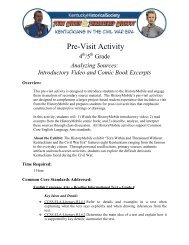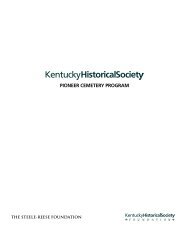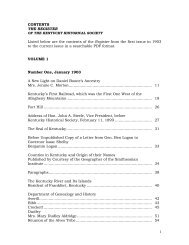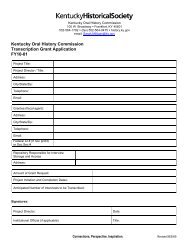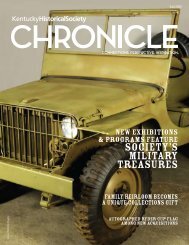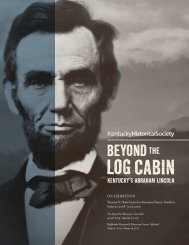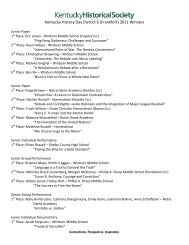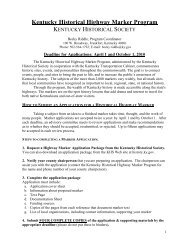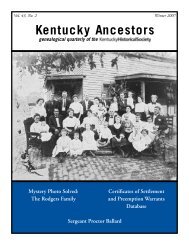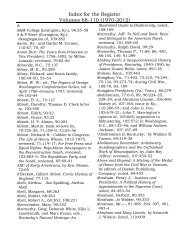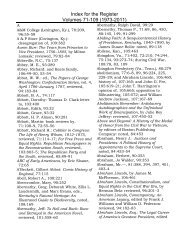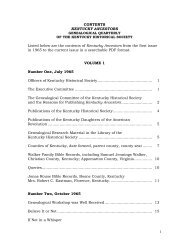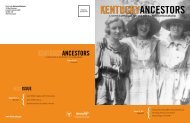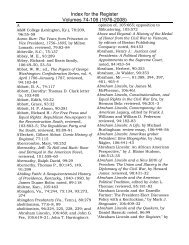Kentucky Ancestors, Volume 46, Number 2 - Kentucky Historical ...
Kentucky Ancestors, Volume 46, Number 2 - Kentucky Historical ...
Kentucky Ancestors, Volume 46, Number 2 - Kentucky Historical ...
You also want an ePaper? Increase the reach of your titles
YUMPU automatically turns print PDFs into web optimized ePapers that Google loves.
sold by a daughter, Catherine (Kate) Bustard, to the<br />
French Legation in Dublin. 25<br />
Ebenezer Bustard died at the dwelling on Lower<br />
Baggot Street in 1882. His lengthy will provided<br />
that his estates, including “stock, crops, cattle, horses,<br />
Carriage houses, saddle horses,” were bequeathed to<br />
his eldest son George who was to hold the total estate<br />
in trust for the benefit of all Ebenezer’s children and<br />
his wife Margaret. Margaret Bustard was specifically<br />
given “all my silver plate and plated wares and all my<br />
carriages, Cars, and Carriage horses” and £20,000.<br />
She and her unmarried daughters could live at<br />
Belleville House and £20,000 was to be invested<br />
for the benefit and support of daughters, Margaret,<br />
Catherine Adelaide Minerva, and Mary Jane Maude<br />
Maria Louisa and their heirs. A cash sum of £3,000<br />
was provided for each of his sons, George, John, and<br />
Robert Tyler. The “residue” of his estate, after all<br />
other provisions had been met, was to be divided with<br />
one-third to his wife and the other two-thirds equally<br />
distributed among “all my children.” 26 According to<br />
one descendant all of the estates were “taken over”<br />
by the Irish Land Commission in 1921. During the<br />
period of the Irish Rebellion and the establishment<br />
of the Irish Free State owners often were required to<br />
sell their land and in some instances land was seized<br />
by the government. The Land Commission was<br />
authorized to acquire land from large land owners for<br />
distribution to former tenants. 27<br />
The Bustard family was an important part of<br />
the development of early Louisville. The Irishman<br />
John Bustard came to Louisville when it was still a<br />
frontier town with great potential for development<br />
and growth. He quickly took advantage of the<br />
opportunities available and established himself in<br />
business while accepting the civic responsibilities<br />
necessary in the development of the community.<br />
He became a prosperous business and financial<br />
leader with considerable land holdings. John<br />
Bustard supported religious and social efforts and<br />
was a respected man in the town. Ebenezer Bustard<br />
continued the family’s involvement in the business<br />
and financial development of Louisville as it grew<br />
from a town into a city. Although foreign-born, the<br />
Bustards’ assimilation into the culture and society of<br />
their new home appeared to be complete and settled.<br />
In the end, however, familial obligations and loyalty<br />
caused the family to abandon their home of seventysix<br />
years and return to Ireland. Perhaps if a second<br />
72 | <strong>Kentucky</strong> <strong>Ancestors</strong><br />
generation had matured and been established in<br />
the city some of the family would have remained in<br />
Louisville. Instead the surviving children of Ebenezer<br />
and Margaret Bustard settled and lived their lives<br />
in Ireland except for John (Jack) Bustard, born in<br />
Louisville, who immigrated to New Zealand and<br />
lived there in the city of Wellington. One of his<br />
daughters eventually settled in Australia. 28<br />
ENDNOTES<br />
1 The memorial and graves are located in Section 5, lot<br />
175, Cave Hill Cemetery, Louisville, <strong>Kentucky</strong>.<br />
2 John R. Keble, The History of the Parish and Manor<br />
House of Bishopthorpe (Leeds, 1905), 11-12, 16-19.<br />
3 Early <strong>Kentucky</strong> Settlers: The Records of Jefferson<br />
County, <strong>Kentucky</strong>, From the Filson Club History<br />
Quarterly (Baltimore, 1988), 410.<br />
4 Calendar of Bonds and Powers of Attorney, Book No.<br />
1, Jefferson County, <strong>Kentucky</strong>: 252; Deed Book, No.<br />
7, Jefferson County, <strong>Kentucky</strong>: 94, 118, 506.<br />
5 <strong>Kentucky</strong> Gazette, 20 March 1804, quoted in Karen<br />
M. Green, The <strong>Kentucky</strong> Gazette: 1801-1820<br />
(Baltimore, 1985), 41.<br />
6 County Court Minute Book, No. 7, 1805-07,<br />
Jefferson County, <strong>Kentucky</strong>, 4, 68.<br />
7 Ibid., No. 8, 1807-09, Jefferson County, <strong>Kentucky</strong>,<br />
156.<br />
8 Old Chancery Court Case Index, 1780-1845,<br />
Jefferson County, <strong>Kentucky</strong>, 50-51.<br />
9 Louisville Gazette and Western Advertiser, vol. 1, no.<br />
2, 1 December 1807; The Louisville Correspondent, vol.<br />
4, no. 20, Monday, 22 January 1816. These citations<br />
are found in Lola Frazer Crowder, Early Louisville<br />
<strong>Kentucky</strong> Newspaper Abstracts, 1806-28 (Galveston,<br />
1995), 3, 44.<br />
10 Ibid, Louisville Public Advertiser, Vol. 1, No. 98,<br />
Wednesday, 15 September 1819. See case files 395,<br />
780, 812, 942, 1090, 1255, 1276, 1322, 1339, 1<strong>46</strong>1,<br />
1662, 1696, 1891 , 2241, and 2242 of the Chancery<br />
Court of Jefferson County, <strong>Kentucky</strong>.<br />
11 Circuit Court in Chancery, Jefferson County,<br />
<strong>Kentucky</strong>, September Term, 1834: Circuit Court in<br />
Chancery, Jefferson County, <strong>Kentucky</strong>, Chancery File<br />
2241.<br />
12 Will Book 3, 1834-<strong>46</strong>, Jefferson County, <strong>Kentucky</strong>:<br />
97; Deed Book 7, Jefferson County, <strong>Kentucky</strong>: 118.<br />
13 U.S. Census, 1820, Jefferson County, <strong>Kentucky</strong>, 21;



